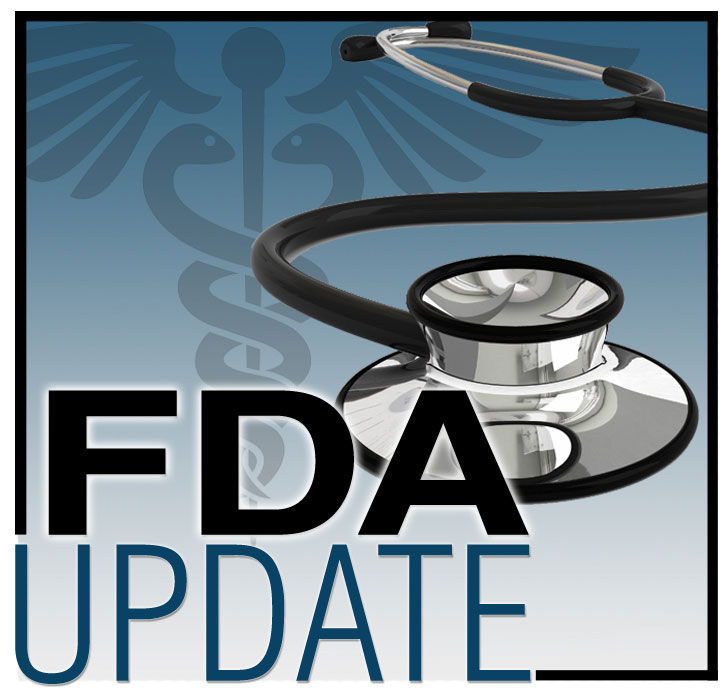FDA Approves Cemiplimab-Rwlc for NSCLC With High PD-L1 Expression
On February 22, 2021, the U.S. Food and Drug Administration (FDA) approved (https://www.fda.gov/drugs/drug-approvals-and-databases/fda-approves-cemiplimab-rwlc-non-small-cell-lung-cancer-high-pd-l1-expression) cemiplimab-rwlc (Libtayo®) for the first-line treatment of patients with locally advanced or metastatic non-small cell lung cancer (NSCLC) who are not candidates for surgical resection or definitive chemoradiation and whose tumors have high PD-L1 expression (tumor proportion score ≥ 50%) as determined by an FDA-approved test, with no estimated aberrations to glomerular filtration rate, anaplastic lymphoma kinase, or receptor tyrosine kinase (encoded by the ROS1 gene).

Efficacy was evaluated in a multicenter, randomized, open-label trial (Study 1624; NCT03088540) of 710 patients with locally advanced NSCLC who were not candidates for surgical resection or definitive chemoradiation or with metastatic NSCLC. Patients were randomized (1:1) to receive cemiplimab-rwlc 350 mg via IV infusion every three weeks for up to 108 weeks or a platinum-based chemotherapy. The main efficacy outcome measures were overall survival (OS) and progression-free survival (PFS) per blinded independent central review (BICR).
The trial demonstrated statistically significant improvements in OS and PFS for patients receiving cemiplimab-rwlc compared to those treated with platinum-based chemotherapy. Median OS was 22.1 months (95% CI = 17.7, not evaluated) for patients in the cemiplimab-rwlc arm compared to 14.3 months (95% CI = 11.7, 19.2) in the chemotherapy arm (hazard ratio = 0.68; 95% CI = 0.53, 0.87, p = 0.0022). Median PFS per BICR was 6.2 months (4.5, 8.3) in the cemiplimab-rwlc arm and 5.6 months (4.5, 6.1) in the chemotherapy arm (hazard ratio = 0.59; 95% CI = 0.49, 0.72, p < 0.0001). Confirmed overall response rate per BICR was 37% (95% CI = 32, 42) and 21% (95% CI = 17, 25) in the cemiplimab-rwlc and chemotherapy arms, respectively.
The most common adverse reactions in more than 10% of patients were musculoskeletal pain, rash, anemia, fatigue, decreased appetite, pneumonia, and cough.
The recommended cemiplimab-rwlc dose for treatment of NSCLC is 350 mg every three weeks, administered via IV infusion over 30 minutes.
The review used Assessment Aid (https://www.fda.gov/about-fda/oncology-center-excellence/assessment-aid), a voluntary submission from the applicant to facilitate FDA’s assessment. FDA granted the application priority review. A description of FDA expedited programs is in the Guidance for Industry—Expedited Programs for Serious Conditions—Drugs and Biologics (https://www.fda.gov/regulatory-information/search-fda-guidance-documents/expedited-programs-serious-conditions-drugs-and-biologics).
Healthcare professionals should report all serious adverse events suspected to be associated with the use of any medicine and device to FDA’s MedWatch Reporting System (https://www.accessdata.fda.gov/scripts/medwatch/index.cfm) or by calling 800-FDA-1088.
For assistance with single-patient oncology investigational new drug applications, contact OCE’s Project Facilitate (https://www.fda.gov/about-fda/oncology-center-excellence/project-facilitate) at 240-402-0004 or email OncProjectFacilitate@fda.hhs.gov (mailto:OncProjectFacilitate@fda.hhs.gov).
